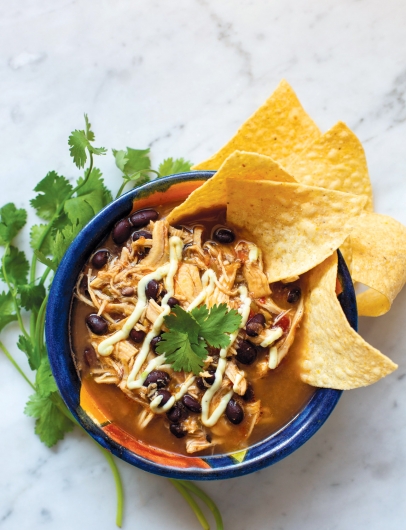Fundamentals of Soup
Ahhh for the love of soup! Time after time on snow covered weekend afternoons, I am drawn to my kitchen for sustenance and for some alone time in the kitchen to play around with whatever ingredients I have on hand. Typically on these kind of days, I wind up with a big pot of soup on the stove, maybe some sort of baked good to pair with it, and a curl-up on the sofa with a long movie. Sounds good, right?
Before we get to the curl-up and a movie part, there should be some reflection on the mechanics of soup making, the types of soups, and well, a consideration of what it is that actually makes a great soup. So straighten up, eyes forward, soup class is session!
THE BASE
The base is the foundation of your soup…the soup part of the soup, if you will. It can be a flavorful chicken, beef, or fish stock, all properly made by roasting and/or simmering bones with herbs and aromatics. Now, stocks do not necessarily have to be labor intensive with you simmering away carcasses for hours, but homemade stocks definitely make all the difference. There are some wonderful commercial premade stocks on hand located in you nearest grocery store. Just make sure they are of good quality and aren’t loaded with a bunch of ingredients that you would need a chemistry degree to understand.
Soup bases can also be milk and other dairy. Consider classics like a New England clam chowder, vichychoisse, or the Polish zupa mleczna. Milk based soups probably came from that time when no one threw anything out and dairy farmers had just enough leftover to use in something besides cheese and yogurts. If you are fortunate enough to not suffer from lactose intolerance, dairy based soups can be used to help with digestion, for a quick and easy breakfast, or for those who are feeling a little puny and need a pick me up.
Having a tomato based soup automatically takes some of us back to childhood. Opening up that red and white can full of orange gelatinous goodness and pairing it along with a pan-fried grilled cheese made any snow day home from school the best day ever. Hopefully in our growth to adulthood, our palates broadened and we were more adventurous with other soups such as minestrone, gazpacho, and the adult version of our childhood favorite, a simple tomato basil soup.
Keep in mind when it comes to choosing a base, your soup does not have to be one or the other. It can be a combination of two or even all three!
THE FAT
Traditionally when making soups, there is always some kind of fat involved when starting your masterpiece. Olive oil, grapeseed oil, butter, or even palm oil can work. There is also the possibility of rendering out animal fats; think bacon or salt pork. Starting out with a fat allows one to saute root vegetables and other goods that flavor and add body to our soups. Most peppers and anything in the pepper family are fat soluble, so to bring out spice and flavor in your soup, start those ingredients in whatever fat you are using!
THE MEAT
If you are using meat, that is. What is chicken noodle soup without the chicken or chili without ground beef or beautiful bouride and bouillabaisse without the fruit de mer? Choose whatever meat you prefer and keep in mind that this is a great way to use up leftovers. You may also want to pair the meat with whatever base you’re using…chicken with chicken stock is perfect. Medium rare steak with milk…a big NOPE!
THE VEGETABLES
The vegetables you add to your soup not only build the meal profile of the dish but also add flavor and color. Most homestyle soups will start out with a mirepoix (onions, celery, carrots). Adding other root vegetables, along with garlic, is also encouraged. Consider leafy greens like a chiffonade of spinach or kale. Potatoes, corn, lentils, or other legumes are equally as satisfying and make a hearty soup! Needing an easy fix when it comes to veggies? Pick up a bag of frozen mixed vegetables and add them to the pot!
HERBS AND SPICES
Salt and pepper of course…the amounts you use depends on you. As with anything you season with salt and pepper, it is easier to add than it is to take away. Most times with soups especially, I choose to season towards the end of cooking. As liquid reduces in simmering, the more concentrated in flavor your seasonings, including salt, become.
However, as I have mentioned before concerning pepper, certain spices bloom in fats. Fry spices like cumin and coriander, turmeric, black pepper, chile peppers flakes, in fat. This brings out certain fat soluble compounds and adds to the all around flavor of your soup or dish. This technique also distributes the flavor evenly throughout the dish at this first step, rather than if you had added it later or once the soup is rolling and boiling.
Herbs are always welcomed in soups! Add dried herbs at the beginning of your soup making process. This will allow the herbs to fully develop their flavor in the soup as opposed to adding late in the game when you will be barely able to taste their herbal goodness. When it comes to fresh herbs, add at the end of cooking or just before serving. That way their flavors are still bright and fresh. Our class session has now ended. Go make some soup!
Chicken Tortilla Soup with Avocado Crema





